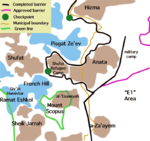Khirbet Almit
Ancient Jewish Persian historyBar Kokhba hiding complexesBar Kokhba revoltCoinage metals and alloysIron Age Asia ... and 2 more
Jewish Ptolemaic historyJudea (Roman province)

Khirbet Almit is an archaeological site in the West Bank, occupied from the Middle Bronze Age to the Ottoman period. It is located in the Judaean Desert about 4 km northeast of Mount Scopus and about 1.5 km southeast of 'Anata. The site is situated on the top of two peaks of one hill at an altitude of 638 meters above sea level, near Nahal Zimri and on the border of the Nahal Prat Nature Reserve.
Excerpt from the Wikipedia article Khirbet Almit (License: CC BY-SA 3.0, Authors, Images).Khirbet Almit
4371,
Geographical coordinates (GPS) Address Nearby Places Show on map
Geographical coordinates (GPS)
| Latitude | Longitude |
|---|---|
| N 31.82375 ° | E 35.274555555556 ° |
Address
مقبرة أطفال
4371
Judea and Samaria, Palestinian Territories
Open on Google Maps






